Papers by Michelle Martínez-Montemayor
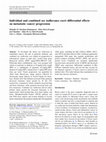
Clinical & Experimental Metastasis, 2010
To investigate the effects soy isoflavones in established cancers, the role of genistein, daidzei... more To investigate the effects soy isoflavones in established cancers, the role of genistein, daidzein, and combined soy isoflavones was studied on progression of subcutaneous tumors in nude mice created from green fluorescent protein (GFP) tagged-MDA-MB-435 cells. Following tumor establishment, mice were gavaged with vehicle or genistein or daidzein at 10 mg/kg body weight (BW) or a combination of genistein (10 mg/kg BW), daidzein (9 mg/kg BW), and glycitein (1 mg/kg BW) three times per week. Tumor progression was quantified by whole body fluorescence image analysis followed by microscopic image analysis of excised organs for metastases. Results show that daidzein increased while genistein decreased mammary tumor growth by 38 and 33% respectively, compared to vehicle. Daidzein increased lung and heart metastases while genistein decreased bone and liver metastases. Combined soy isoflavones did not affect primary tumor growth but increased metastasis to all organs tested, which include lung, liver, heart, kidney, and bones. Phosphoinositide-3-kinase (PI3-K) pathway real time PCR array analysis and western blotting of excised tumors demonstrate that genistein significantly downregulated 10/84 genes, including the Rho GTPases RHOA, RAC1, and CDC42 and their effector PAK1. Daidzein significantly upregulated 9/84 genes that regulate proliferation and protein synthesis including EIF4G1, eIF4E, and survivin protein levels. Combined soy treatment significantly increased gene and protein levels of EIF4E and decreased TIRAP gene expression. Differential regulation of Rho GTPases, initiation factors, and survivin may account for the disparate responses of breast cancers to genistein and daidzein diets. This study indicates that consumption of soy foods may increase metastasis.
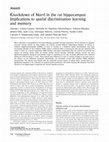
Learning & memory (Cold Spring Harbor, N.Y.)
Nurr1 expression is up-regulated in the brain following associative learning experiences, but its... more Nurr1 expression is up-regulated in the brain following associative learning experiences, but its relevance to cognitive processes remains unclear. In these studies, rats initially received bilateral hippocampal infusions of control or antisense oligodeoxynucleotides (ODNs) 1 h prior to training in a holeboard spatial discrimination task. Such pre-training infusions of nurr1 antisense ODNs caused a moderate effect in learning the task and also impaired LTM tested 7 d later. In a second experiment, ODN infusions were given immediately after the animals had received two sessions of training, during which all animals showed normal learning. Although antisense treated rats were significantly impaired during the post-infusion stages of acquisition of the task, no group differences were observed during the LTM test given 7 d later. These animals were subjected 3 d later to reversal training in the same maze in the absence of any additional treatments. Remarkably, rats previously treated w...

PLoS ONE, 2013
The medicinal mushroom Ganoderma lucidum (Reishi) was tested as a potential therapeutic for Infla... more The medicinal mushroom Ganoderma lucidum (Reishi) was tested as a potential therapeutic for Inflammatory Breast Cancer (IBC) using in vivo and in vitro IBC models. IBC is a lethal and aggressive form of breast cancer that manifests itself without a typical tumor mass. Studies show that IBC tissue biopsies overexpress E-cadherin and the eukaryotic initiation factor 4GI (eIF4GI), two proteins that are partially responsible for the unique pathological properties of this disease. IBC is treated with a multimodal approach that includes non-targeted systemic chemotherapy, surgery, and radiation. Because of its non-toxic and selective anti-cancer activity, medicinal mushroom extracts have received attention for their use in cancer therapy. Our previous studies demonstrate these selective anti-cancer effects of Reishi, where IBC cell viability and invasion, as well as the expression of key IBC molecules, including eIF4G is compromised. Thus, herein we define the mechanistic effects of Reishi focusing on the phosphoinositide-3-kinase (PI3K)/AKT/mammalian target of rapamycin (mTOR) pathway, a regulator of cell survival and growth. The present study demonstrates that Reishi treated IBC SUM-149 cells have reduced expression of mTOR downstream effectors at early treatment times, as we observe reduced eIF4G levels coupled with increased levels of eIF4E bound to 4E-BP, with consequential protein synthesis reduction. Severe combined immunodeficient mice injected with IBC cells treated with Reishi for 13 weeks show reduced tumor growth and weight by ∼50%, and Reishi treated tumors showed reduced expression of E-cadherin, mTOR, eIF4G, and p70S6K, and activity of extracellular regulated kinase (ERK1/2). Our results provide evidence that Reishi suppresses protein synthesis and tumor growth by affecting survival and proliferative signaling pathways that act on translation, suggesting that Reishi is a potential natural therapeutic for breast and other cancers.
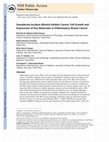
Nutrition and Cancer, 2011
Inflammatory breast cancer (IBC) is the most lethal and least understood form of advanced breast ... more Inflammatory breast cancer (IBC) is the most lethal and least understood form of advanced breast cancer. Its lethality originates from its nature of invading the lymphatic system and absence of a palpable tumor mass. Different from other metastatic breast cancer cells, IBC cells invade by forming tumor spheroids that retain E-cadherin-based cell-cell adhesions. Herein we describe the potential of the medicinal mushroom Ganoderma lucidum (Reishi) as an attractive candidate for anti-IBC therapy. Reishi contains biological compounds that are cytotoxic against cancer cells. We report the effects of Reishi on viability, apoptosis, invasion, and its mechanism of action in IBC cells . Results show that Reishi selectively inhibits cancer cell viability although it does not affect the viability of noncancerous mammary epithelial cells. Apoptosis induction is consistent with decreased cell viability. Reishi inhibits cell invasion and disrupts the cell spheroids that are characteristic of the IBC invasive pathology. Reishi decreases the expression of genes involved in cancer cell survival and proliferation (BCL-2, TERT, PDGFB), and invasion and metastasis (MMP-9), whereas it increases the expression of IL8. Reishi reduces BCL-2, BCL-XL,
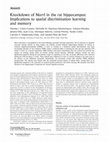
Learning & Memory, 2006
Nurr1 expression is up-regulated in the brain following associative learning experiences, but its... more Nurr1 expression is up-regulated in the brain following associative learning experiences, but its relevance to cognitive processes remains unclear. In these studies, rats initially received bilateral hippocampal infusions of control or antisense oligodeoxynucleotides (ODNs) 1 h prior to training in a holeboard spatial discrimination task. Such pre-training infusions of nurr1 antisense ODNs caused a moderate effect in learning the task and also impaired LTM tested 7 d later. In a second experiment, ODN infusions were given immediately after the animals had received two sessions of training, during which all animals showed normal learning. Although antisense treated rats were significantly impaired during the post-infusion stages of acquisition of the task, no group differences were observed during the LTM test given 7 d later. These animals were subjected 3 d later to reversal training in the same maze in the absence of any additional treatments. Remarkably, rats previously treated with antisense ODNs displayed perseveration: The animals were fixated with the previously learned pattern of baited holes, causing them to be significantly impaired in the extinction of acquired spatial preferences and future learning. We postulate that Nurr1 function in the hippocampus is important for normal cognitive processes. ; fax 787-764-3875. Article is online at
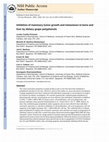
Clinical & Experimental Metastasis, 2009
The cancer preventive properties of grape products such as red wine have been attributed to polyp... more The cancer preventive properties of grape products such as red wine have been attributed to polyphenols enriched in red wine. However, much of the studies on cancer preventive mechanisms of grape polyphenols have been conducted with individual compounds at concentrations too high to be achieved via dietary consumption. We recently reported that combined grape polyphenols at physiologically relevant concentrations are more effective than individual compounds at inhibition of ERα(−), ERβ(+) MDA-MB-231 breast cancer cell proliferation, cell cycle progression, and primary mammary tumor growth (Schlachterman et al., Transl Oncol 1:19-27, 2008). Herein, we show that combined grape polyphenols induce apoptosis and are more effective than individual resveratrol, quercetin, or catechin at inhibition of cell proliferation, cell cycle progression, and cell migration in the highly metastatic ER (−) MDA-MB-435 cell line. The combined effect of dietary grape polyphenols (5 mg/kg each resveratrol, quercetin, and catechin) was tested on progression of mammary tumors in nude mice created from green fluorescent protein-tagged MDA-MB-435 bone metastatic variant. Fluorescence image analysis of primary tumor growth demonstrated a statistically significant decrease in tumor area by dietary grape polyphenols. Molecular analysis of excised tumors demonstrated that reduced mammary tumor growth may be due to upregulation of FOXO1 (forkhead box O1) and NFKBIA (IκBα), thus activating apoptosis and potentially inhibiting NfκB (nuclear factor κB) activity. Image analysis of distant organs for metastases demonstrated that grape polyphenols reduced metastasis especially to liver and bone. Overall, these results indicate that combined dietary grape polyphenols are effective at inhibition of mammary tumor growth and sitespecific metastasis.
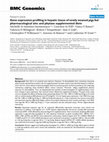
BMC Genomics, 2008
Background: Zinc (Zn) is an essential trace element. However, Zn bioavailability from commonly co... more Background: Zinc (Zn) is an essential trace element. However, Zn bioavailability from commonly consumed plants may be reduced due to phytic acid. Zn supplementation has been used to treat diarrheal disease in children, and in the U.S. swine industry at pharmacological levels to promote growth and fecal consistency, but underlying mechanisms explaining these beneficial effects remain unknown. Moreover, adding supplemental phytase improves Zn bioavailability. Thus, we hypothesized that benefits of pharmacological Zn supplementation result from changes in gene expression that could be further affected by supplemental phytase. The goal of this study was to investigate the effects of feeding newly weaned pigs dietary Zn (150, 1,000, or 2,000 mg Zn/kg) as Zn oxide with or without phytase [500 phytase units (FTU)/kg] for 14 d on hepatic gene expression. Liver RNA from pigs fed 150, 1,000, or 2,000 mg Zn/kg, or 1,000 mg Zn/kg with phytase (n = 4 per treatment) was reverse transcribed and examined using the differential display reverse transcription polymerase chain reaction technique. Liver RNA from pigs fed 150 or 2,000 mg Zn/kg (n = 4 per treatment) was also evaluated using a 70-mer oligonucleotide microarray.
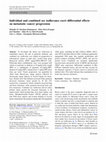
Clinical & Experimental Metastasis, 2010
To investigate the effects soy isoflavones in established cancers, the role of genistein, daidzei... more To investigate the effects soy isoflavones in established cancers, the role of genistein, daidzein, and combined soy isoflavones was studied on progression of subcutaneous tumors in nude mice created from green fluorescent protein (GFP) tagged-MDA-MB-435 cells. Following tumor establishment, mice were gavaged with vehicle or genistein or daidzein at 10 mg/kg body weight (BW) or a combination of genistein (10 mg/kg BW), daidzein (9 mg/kg BW), and glycitein (1 mg/kg BW) three times per week. Tumor progression was quantified by whole body fluorescence image analysis followed by microscopic image analysis of excised organs for metastases. Results show that daidzein increased while genistein decreased mammary tumor growth by 38 and 33% respectively, compared to vehicle. Daidzein increased lung and heart metastases while genistein decreased bone and liver metastases. Combined soy isoflavones did not affect primary tumor growth but increased metastasis to all organs tested, which include lung, liver, heart, kidney, and bones. Phosphoinositide-3-kinase (PI3-K) pathway real time PCR array analysis and western blotting of excised tumors demonstrate that genistein significantly downregulated 10/84 genes, including the Rho GTPases RHOA, RAC1, and CDC42 and their effector PAK1. Daidzein significantly upregulated 9/84 genes that regulate proliferation and protein synthesis including EIF4G1, eIF4E, and survivin protein levels. Combined soy treatment significantly increased gene and protein levels of EIF4E and decreased TIRAP gene expression. Differential regulation of Rho GTPases, initiation factors, and survivin may account for the disparate responses of breast cancers to genistein and daidzein diets. This study indicates that consumption of soy foods may increase metastasis.

Uploads
Papers by Michelle Martínez-Montemayor